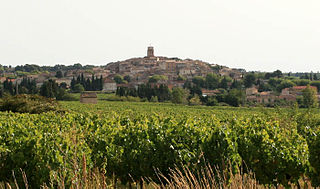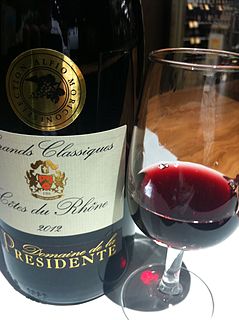
The Rhône wine region in Southern France is situated in the Rhône valley and produces numerous wines under various Appellation d'origine contrôlée (AOC) designations. The region's major appellation in production volume is Côtes du Rhône AOC.
Côtes du Roussillon is an Appellation d'Origine Contrôlée for wines made in the Roussillon wine region of France. It is the least selective AOC in the Roussillon region. In 2002, 21,048,500 litres of Côtes du Roussillon were produced, 68% red, 28% rosé and 4% white. Grenache is the dominant variety in Red and Rosé. According to the AOC rules, red wines must, though, be made with at least three varieties of grapes. The total of the two main variety grapes should not make more than 90% of the blend, and there must not be more than 60% of Carignan in it.
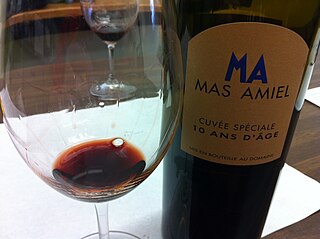
Maury is an Appellation d'Origine Contrôlée (AOC) for fortified vin doux naturel wines made in the Roussillon wine region of France. Almost all wines are red, made from at least 75% Grenache noir (Garnacha). Other permitted grapes are Grenache blanc, Grenache gris, Macabeu (Macabeo), Malvoisie du Roussillon (Tourbat), Syrah, Muscat and other local varieties. Although the grapes are different, they are used and marketed very much like port. It is made in the communes of Maury, Saint-Paul-de-Fenouillet, Lesquerde, Tautavel and Rasiguères. The AOC was granted in 1936.

Condrieu is a French wine-growing Appellation d'Origine Contrôlée (AOC) located in the northern Rhône, near Vienne and to the south of the Côte-Rôtie AOC. The vineyards are situated in the seven communes of Limony, Chavanay, Malleval, Saint-Michel-sur-Rhône, Saint-Pierre-de Boeuf, Vérin, and Condrieu. These communes are in the French departments of Ardèche, Rhône and Loire on the steep slopes of the foothills of the Massif Central on the right bank of the Rhône. The four southernmost communes can also produce wine under the Saint-Joseph AOC. The wines made in this AOC are exclusively white, from the Viognier grape, which may have originated in the region. Within Condrieu is the enclave AOC of Château-Grillet, producing wines that are also 100% Viognier. The Condrieu AOC was officially created in 1940.

Château-Grillet is a wine-growing AOC in the northern Rhône wine region of France, near Vienne, which produces white wine from Viognier grapes. The whole appellation, which is only 3.8 hectares in size, is owned by a single winery, Château-Grillet. The appellation was officially created in 1936.
Côtes de Toul is an Appellation d'Origine Contrôlée (AOC) for French wine produced in the département of Meurthe-et-Moselle in the Lorraine région. The Côtes de Toul vineyards cover 110 hectares in an area close to Toul, to the west of the city of Nancy. The area of production includes the following communes: Blénod-lès-Toul, Bruley, Bulligny, Charmes-la-Côte, Domgermain, Lucey, Mont-le-Vignoble and Pagney-derrière-Barine. Annual production is 4,500 hectoliter, corresponding to 600,000 bottles.
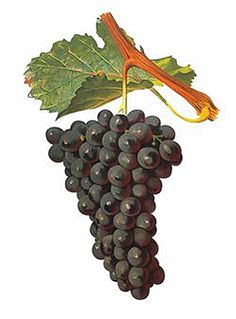
Terret noir is a dark-skinned French wine grape variety grown primarily in the Rhône valley region of France. It is a mutation of the old Vitis vinifera vine Terret. It is a permitted blending grape for Châteauneuf-du-Pape. Like the related Terret gris and Terret blanc, the vine tends to bud late and grow vigorously. Terret noir produces a light color wine that is perfumed and tart.

Richebourg is an Appellation d'origine contrôlée (AOC) and Grand Cru vineyard for red wine in the Côte de Nuits subregion of Burgundy, with Pinot noir as the main grape variety. It is situated within the commune of Vosne-Romanée, and borders La Romanée and Romanée-Conti in the south, Romanée-Saint-Vivant in the east and Vosne-Romanée Premier Cru vineyards in the north and west. The AOC was created in 1936.

Clos de Tart is an Appellation d'origine contrôlée (AOC) and Grand Cru vineyard for red wine in the Côte de Nuits subregion of Burgundy, with Pinot noir as the main grape variety. It is situated in the commune of Morey-Saint-Denis in the Côte-d'Or département. Clos de Tart is located in the southern part of the commune, starts immediately west (uphill) of the village itself, and borders to the Grand Cru vineyard Bonnes Mares in the south and Clos des Lambrays in the north. The AOC was created in 1939, and the Clos part of its name refers to a wall-enclosed vineyard.

Beaumes de Venise is an appellation of wines from the eastern central region of the southern half of the Rhône Valley. It produces wines of two distinctly different types:
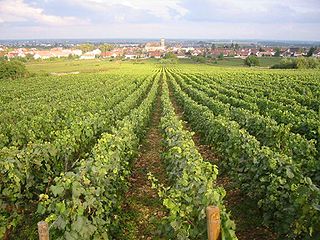
Marsannay wine is produced in the communes of Marsannay-la-Côte, Couchey and Chenôve in the Côte de Nuits subregion of Burgundy. The Appellation d'origine contrôlée (AOC) Marsannay may be used for red and rosé wine with Pinot noir, as well as white wine with Chardonnay as the main grape variety. Red wine accounts for the largest part of the production, around two-thirds. Marsannay is the only village-level appellation which may produce rosé wines, under the designation Marsannay rosé. All other Burgundy rosés are restricted to the regional appellation Bourgogne. There are no Grand Cru or Premier Cru vineyards in Marsannay. The Marsannay AOC was created in 1987, and is the most recent addition to the Côte de Nuits.

Mercurey wine is produced in the communes of Mercurey and Saint-Martin-sous-Montaigu in the Côte Chalonnaise subregion of Burgundy. The Appellation d'origine contrôlée (AOC) Mercurey may be used for red and white wine with respectively Pinot noir and Chardonnay as the main grape variety. The production of red wine dominates, with almost 80 per cent.

Pommard wine is produced in the commune of Pommard in Côte de Beaune of Burgundy. The Appellation d'origine contrôlée (AOC) Pommard is only used for red wine with Pinot noir as the main grape variety. There are no Grand Cru vineyards within Pommard, but several highly regarded Premier Cru vineyards. The AOC was created in 1937.

Chorey-les-Beaune wine is produced in the commune of Chorey-les-Beaune in Côte de Beaune of Burgundy. The Appellation d'origine contrôlée (AOC) Chorey-les-Beaune, which may also be written Chorey, may be used for red and white wine with respectively Pinot noir and Chardonnay as the main grape variety. More than 90 per cent of the production consists of red wine. There are no Grand Cru and no Premier Cru vineyards within Chorey-les-Beaune wine. Chorey-les-Beaune wine is sometimes declassified to Côte de Beaune-Villages, which is an appellation that allow négociants to sell wine blended from several villages. The AOC was created in 1970.

Gevrey-Chambertin wine is produced in the communes of Gevrey-Chambertin and Brochon in the Côte de Nuits subregion of Burgundy. The Appellation d'origine contrôlée (AOC) Gevrey-Chambertin may be used only for red wine with Pinot noir as the main grape variety. There are nine Grand Cru vineyards within the commune of Gevrey-Chambertin, Chambertin and eight others called Chambertin in combination with something else, such as Chapelle-Chambertin. While Gevrey-Chambertin also has several highly regarded Premier Cru vineyards, it has a particularly large amount of vineyards at the village level for a Côte de Nuits appellation. This is because the vineyards of the AOC stretch further to the east than in most neighbouring AOCs.

Hautes-Côtes de Beaune is a subregion of the Burgundy wine region located to the west of the Côte de Beaune subregion. While Côte de Beaune consists of vineyards located on or close to the main Côte d'Or escarpment, Hautes-Côtes de Beaune covers the area on top of the escarpment, and the adjacent area of various valleys and slopes. Only one appellation d'origine contrôlée (AOC), Bourgogne Hautes-Côtes de Beaune, covers the entire subregion; there are no specific AOCs named after villages in this subregion, and also no Premier Cru vineyards. This AOC may be used for red and rosé wines with Pinot noir as the main grape variety, as well as white wines with Chardonnay as the main grape variety, and was created in 1961.
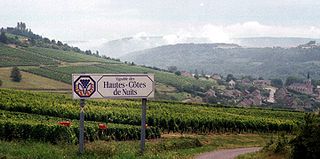
Hautes-Côtes de Nuits is a subregion of the Burgundy wine region located to the west of the Côte de Nuits subregion. While Côte de Nuits consists of vineyards located on or close to the main Côte d'Or escarpment, Hautes-Côtes de Nuits covers the area on top of the escarpment, and the adjacent area of various valleys and slopes. Only one appellation d'origine contrôlée (AOC), Bourgogne Hautes-Côtes de Nuits, covers the entire subregion; there are no specific AOCs named after villages in this subregion, and also no Premier Cru vineyards. This AOC may be used for red and rosé wines with Pinot noir as the main grape variety, as well as white wines with Chardonnay as the main grape variety, and was created in 1961.






